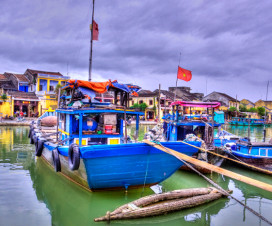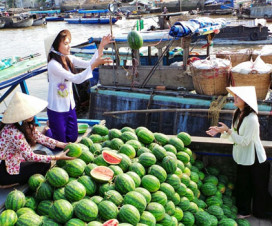HANOI, Vietnam — Close your eyes in the streets of Hanoi Old Quarter and you’ll experience two sensations. The first is the earsplitting cacophony of conversation, cars, clamor and chaos. The second is the realization that closing your eyes for very long in such a crowded place can be unwise, unless you enjoy being jostled, bumped, hustled, shouted at, or maybe even knocked down.
Such is the Vietnamese capital, lurching into the 21st century with the swirl of unfettered street capitalism set to the soundtrack of Communist proclamations.
Everywhere people are buying, selling, hawking goods and offering services, while nationalistic music and announcements about keeping streets clean play regularly in the background. Six million people live in this former colonial metropolis; add hundreds of thousands more who jammed Hanoi last fall for the celebration marking its 1,000th anniversary, and you sense that this already dizzying city is spinning into a new era.
This is not to say that traditions are endangered. The Old Quarter is arguably the epicenter for the city’s connections to its past. Wander its crisscross of streets — with tall trees, narrow buildings, louvered windows and people’s lives spilling onto sidewalks — and you’ll discover a district known as 36 Streets, named for the craft guilds that populated the neighborhood over the centuries, mixing Vietnamese and Chinese merchants and artisans together. Silk Street (Hang Gai), Silver Street (Hang Bac), Sails Street (Hang Buom), among others, all offer their crafts and other goods for tourists or locals. The Old Quarter’s oldest building, the Bach Ma (White Horse) Temple, dates back to Hanoi’s original incarnation as the imperial city of Thang Long — Soaring Dragon.
For culinary traditions, Cha Ca La Vong is a nondescript restaurant on Cha Ca Street that’s been serving up one dish for more than a century. Sit down at a communal tables shared by random guests — common language not required — and forget the menu. Waiters bring out tabletop, gas-fired stoves in which chunks of marinated, turmeric-coated whitefish are fried in oil — by patrons themselves — along with dill, chives and other greens. Dump the mixture over rice noodles, top with peanuts and wash it down with a draft beer known as bia hoi. The fish itself doesn’t deserve many superlatives and tourists have pushed up prices, but it’s still worth the experience. You can also find bia hoi at the corner of Luong Ngoc Quyen and Dinh Liet streets, where backpacker tourists outnumber the Vietnamese sitting on the stools.
Pho is the dish Vietnam is best known for — a steamy broth of beef or chicken with noodles, greens, star anise and spices. It’s served up everywhere, and everyone has their own spice secret. Order a bowl from a sidewalk vendor, squat on a plastic stool a foot or so from the traffic, savor the broth and watch the crush of people go by. You can also sop up good soup in quieter, though less interesting settings in the indoor comforts of the chain restaurant Pho 24.
Vietnam is one of the world’s top coffee exporters, and it’s known for bitter, super-strong coffee, lightened with condensed milk. You may also see ads for ca phe chon, the coffee famously brewed from beans that have been digested — in one end, then out the other — by weasel-like animals known as civets. Real civet coffee is extremely expensive — $100 a cup — so beware of imitations, which are extremely common, particularly in areas frequented by tourists.
http://www.news-press.com
Tourists ride in the Old Quarter neighborhood in Hanoi, Vietnam. / The Associated Press file photo
If you go
Getting there: No major international carriers serve Hanoi’s Noi Bai airport directly from the United States or Europe. But travelers can easily connect via flights from Bangkok, Singapore, Seoul, Hong Kong or other Asian hubs.
Tips: May to September is the hottest time of year. Travelers from most countries need visa to Vietnam, usually obtained ahead of time, though if crossing the border by land, it’s an easy procedure to get a stamp for your passport. U.S. citizens can get them through the Vietnamese Embassy in Washington or through online visa processing services.
Accommodations: Hanoi has hotels, hostels, boutique accommodations and bed-and-breakfasts to suit any traveler’s budget. Most Old Quarter hotels are midrange ($25-$65 a night) such as the Classic I Hotel, Ta Hien Street, or the Paradise hanoi Hotel, Hang Chieu Street. Outside the Old Quarter, modest hotels range from the Church Hotel, Nha Tho Street, to upscale hotels (from about $125 a night) like the high-rise Sofitel Plaza, Thanh Nien Street, or the Intercontinental Hanoi Westlake, Nghi Tam Street.




